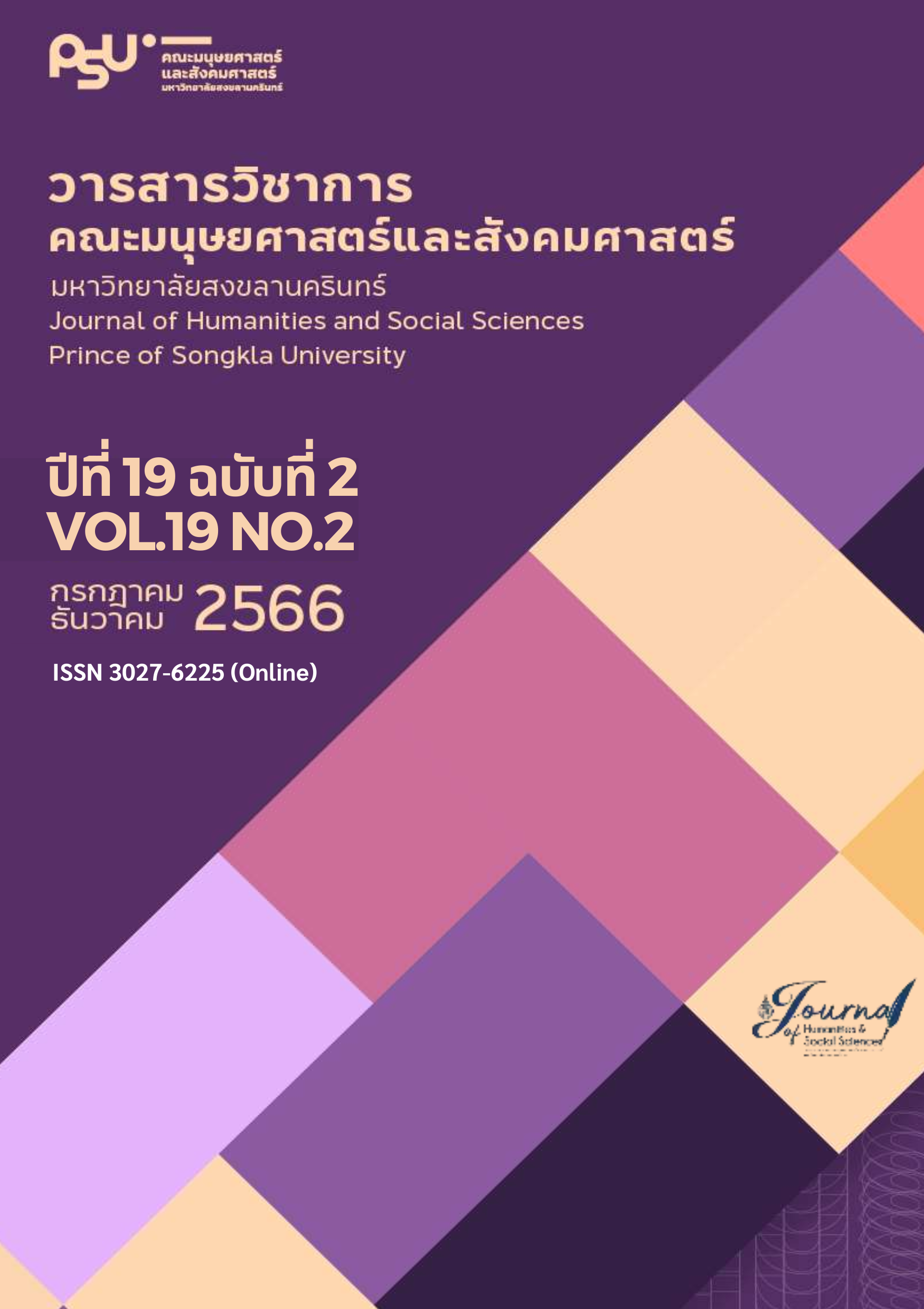การแปลคำเลียนเสียงธรรมชาติในนวนิยายเรื่อง The Council of Animals ของ Nick McDonell
คำสำคัญ:
คำเลียนเสียงธรรมชาติ, การแปล, กลวิธีการแปล, อังกฤษ-ไทย, คำที่เทียบเคียงได้ในภาษาปลายทางบทคัดย่อ
บทความนี้มีวัตถุประสงค์เพื่อศึกษากลวิธีการแปลคำเลียน
เสียงธรรมชาติและนำไปประยุกต์ใช้ในการแปลคำเลียนเสียง ธรรมชาติในนวนิยายเรื่อง The Council of Animals (2021) ของ Nick McDonell ซึ่งเป็นนวนิยายที่มีตัวละครสัตว์เป็นผู้ดำเนินเรื่อง จากภาษาอังกฤษเป็นภาษาไทย จากการศึกษาพบว่า กลวิธีที่ สามารถนำมาแก้ปัญหาการแปลคำเลียนเสียงธรรมชาติได้ดี คือ การเลือกใช้คำเลียนเสียงธรรมชาติที่เทียบเคียงได้ในภาษาปลายทาง (equivalent) ซึ่งจากการทบทวนวรรณกรรมพบว่าเป็นวิธีที่ได้รับ ความนิยมมากที่สุด นอกจากนี้นักแปลอาจเลือกใช้คำเลียนเสียง ธรรมชาติที่เทียบเคียงได้ในภาษาปลายทางร่วมกับกลวิธีทางเสียง เช่น ทำให้เสียงสูงโดยเติมวรรณยุกต์ หรือเพิ่มตัวสะกดให้ดูเสียงยาว ขึ้น ใช้คำเลียนเสียงธรรมชาติที่เทียบเคียงได้ในภาษาปลายทาง ร่วมกับกลวิธีทางเสียงและการทับศัพท์ ใช้คำเลียนเสียงธรรมชาติที่ สร้างใหม่จากกลวิธีทางเสียง ตลอดจนใช้คำยืมหรือทับศัพท์ ส่วนการ ละไม่แปลนั้นเป็นกลวิธีที่ไม่เหมาะสม เนื่องจากจะทำให้ความหมาย เชิงอารมณ์ความรู้สึกขาดหายไป
References
ณัฏฐิรา ทับทิม. (2556). การศึกษาวิธีการและประเภทการแปลคำเลียนเสียงธรรมชาติและคำบอกอาการ หรือสภาพจากภาษาญี่ปุ่นเป็นภาษาไทย. วารสารญี่ปุ่นศึกษาธรรมศาสตร์, 30(1), 41-57. https://so02.tci-thaijo.org/index.php/japanese/article/view/13578
พจนานุกรมฉบับราชบัณฑิตยสถาน พ.ศ. ๒๕๕๔. (ม.ป.ป.). https://dictionary.orst.go.th/
พจนานุกรมฉบับมติชน. (2547). มติชน.
วรรณา แสงอร่ามเรือง. (2563). ทฤษฎีและหลักการแปล. (พิมพ์ครั้งที่ 4). สำนักพิมพ์จุฬาลงกรณ์มหาวิทยาลัย.
สรบุศย์ รุ่งโรจน์สุวรรณ. (2550). โครงการคำเลียนเสียงธรรมชาติในภาษาไทย : รายงานวิจัยฉบับสมบูรณ์. สำนักงานกองทุนสนับสนุนการวิจัย.
Akita, K. (2013). Constraints on the semantic extension of onomatopoeia. Public Journal of Semiotics, 5(1), 21-37. https://doi.org/https://doi.org/10.37693/pjos.2013.5.9646
Azari, R., & Sharififar, M. (2017). Translating onomatopoeia: An attempt toward translation strategies. Review of Applied Linguistics Research, 3(3), 72-92.
Baker, M. (2011). In Other Words: A Coursebook on Translation. Routledge.
Cambridge Advanced Learner’s Dictionary and Thesaurus (4th edition). (2013). Cambridge University Press & Assessment. from https://dictionary.cambridge.org/dictionary/english/
Casas-Tost, H. (2014). Translating onomatopoeia from Chinese into Spanish: a corpus-based analysis. Perspectives, 22(1), 39-55. https://doi.org/10.1080/0907676X.2012.712144
Collins English Dictionary. (2020). https://www.collinsdictionary.com/english/
Fillmore, C. J. (1977). Scenes-and-frames semantics. In Zampolli, A. (Ed.). Linguistic Structures Processing. North Holland Publishing Company.
Flyxe, M. (2002). Translation of Japanese onomatopoeia into Swedish (with focus on lexicalization). Africa & Asia, (2), 54-73.
Fromkin, V. Rodman, R. & Hyams, N. (2010). An Introduction to Language (9th edition). Wadsworth Cengage Learning.
Kakehi, H. (1993). Bungaku sakuhin ni mirareru onomatope hyôgen no nichi-eitaishô. In: H. Kakehi and I. Tamori (Eds.), Onomatopia: gion, gitaigo norakuen (pp. 127-143). Keisô Shobô.
Inose, H. (2008). Translating Japanese onomatopoeia and mimetic words. In A. Pym & A. Perekrestenko (Eds.), Translation project 1 (pp. 97-116). Intercultureal Studies Group. https://www.intercultural.urv.cat/media/upload/domain_317/arxius/TP1/InoseOnomatopoeia.pdf
McDonell, N. (2021). The Council of Animals. Henry Holt and Co.
Merriam-Webster Online Dictionary. (n.d.). https://www.merriam-webster.com/dictionary
Muhaidat, F. M. (2009). A Tale of Two cities in Arabic Translation. [Doctoral dissertation, Binghamton University].
Pinker, S. (1994). The Language Instinct. W. Morrow and Co.
Pischedda, P. S. (2011). A Corpus-Based Study on the Translation of English Ideophones in Italian Picture Books: The Case of the Diary of a Wimpy Kid. Languages, 7(3), 224-237.
Sasamoto, R. (2019). Onomatopoeia and Relevance. Palgrave Macmillan Cham.
Sharifi Moghadam, A., & Ghazizade, A. (2016). Translation of onomatopoeia in holy defense literary works. Review of Applied Linguistics Research, 2(2), 101-116.
Simpson, P. (2014). Stylistics: A Resource Book for Students (2nd edition). Routledge.
Snell-Hornby, M. (2011). Of catfish and blue bananas: Scenes-and-Frames semantics as a contrastive “knowledge system” for translation. In H. V. Dam, J. Engberg, J. and H. Gerzymisch-Arbogast (Eds.) Knowledge Systems and Translation (pp. 193-206). De Gruyter Mouton.
Sugahara, T. (2011). Onomatopoeia in Spoken and Written English: Corpus- and Usage-based Analysis [Doctoral dissertation, Hokkaido University]. https://eprints.lib.hokudai.ac.jp/dspace/bitstream/2115/45138/1/Dissertation%20by%20Takashi%20SUGAHARA.pdf
Tamori, I. & Schourup, L. (1999) Onomatope: Keitai-to imi [Onomatopoeia: Morphology and Semantics. Kurosio Publishers.
Tiwiyanti, L. (2017). An Analysis on Onomatopoeic Words and their Translation Procedures in Harry Potter and The Prisoner of Azkaban and Its Translation Version. Scope Journal of English Language Teaching, 1(1), 39-48. https://doi.org/10.30998/scope.v1i01.870
Toratani, K. (2009). Translating mimetics in Japanese: a cognitive approach. New voices in Translation Studies, 5, 63-77.
Vannerem, M. & Snell-Hornby, M. (1986). Die Szene hinter dem Text: ‘Scenes-and-Frames Semantics’ in de Ubersetzung. In: M. Snell-Hornby (ed.), Übersetzungswissenschaft – eine Neuorientierung: Zur Integrierung von Theorie und Praxis (pp. 184–205). Francke.
Zanetic, F. (2015). Scenes-and-Frames Semantics [Seminar, University of Zadar]. https://www.academia.edu/21459510/Scenes_and_Frames_Semantics
Downloads
เผยแพร่แล้ว
How to Cite
ฉบับ
บท
License
Copyright (c) 2023 วารสารวิชาการคณะมนุษยศาสตร์และสังคมศาสตร์

This work is licensed under a Creative Commons Attribution-NonCommercial-NoDerivatives 4.0 International License.
This article has been published in the Journal of Humanities and Social Sciences at Prince of Songkla University, Pattani Campus.





